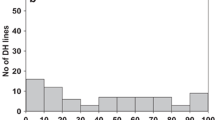Abstract
The brittle rachis of the Tibetan weedrace (Triticum aestivum var. tibetanum) was found to be governed by a single dominant gene on the short arm of chromosome 3D. The new brittle rachis gene was designated Br1. This study also discovered that the type of disarticulation is governed by many genes that may differ from brittle rachis genes. In other words, the same brittle rachis gene may exhibit various types of disarticulation in various genetic backgrounds. So, after the brittle rachis gene (barrel type) in Aegilops tauschii entered hexaploid wheat through the amphidiploid path, it might exhibit the wedge type of disarticulation.
Similar content being viewed by others
References
Cao, W.G., C.L. Scoles & P. Hucl, 1997. The genetics of rachis fragility and glume tenacity in semi-wild wheat. Euphytica 94: 119–124.
Dong, Y.S., D.S. Zheng, D.Y. Qiao, X.Q. Zeng, Z.C. En & X.R. Chen, 1981. Investigation and study on Yunnan wheat (Triticum aestivum ssp. yunnanense King) (in Chinese). Acta Agronomica Sinica 7: 145–151.
Dorofeev, V.F. & N.A. Navruzbekov, 1982. Genetic aspects of easy threshing and rachis strength in naked-grained wheats. Doklady Vsesoyuznoi Ordena Lenina i Ordena Trudovogo Krasnogo Znameni Akademii Sel'skokhozyaistvennykh Nauk Imeni V.I. Lenina. (2): 3–6.
Kerber, E.R. & G. Rowland, 1972. New cytogenetic evidence on the origin of free-threshing character in hexaploid wheat. Canad. J. Genet. and Cytol. 14: 730–731.
Kihara, H. & F. Lilienfeld, 1949. A new synthesized 6X-wheat. Proc. 8th Intern. Congr. Genet., Hereditas, suppl. vol.: 307–319.
Kihara, H., M. Okamoto, M. Ikegami, J. Tabush, H. Suemoto & Y. Yamane, 1950. Morphology and fertility of five new synthesized hexaploid wheats (in Japanese). Seiken Ziho 4: 127–140.
Mac Key, J., 1966. Species relationship in Triticum. Proc. 2nd Intern. Wheat Genet. Symp., Lund, Sweden, Hereditas (Suppl.) 2: 237–276.
McIntosh, R.A. & J.E. Cusick, 1987. Linkage map of hexaploid wheat. In: Heyne, E.G. (Ed.), Wheat and wheat improvement–agronomy monograph No. 13, Second Edition. Wisconsin, USA, ASA-CSSA-SSSA, 289–297.
Shao, Q.Q., C.S. Li & C.R. Basang, 1980. Semi-wild wheat from Xizang (Tibet) (in Chinese). Acta Genetica Sinica 7: 150–156.
Tsunewaki, K., S. Yamada & N. Mori, 1990. Genetical studies on a Tibetan semi-wild wheat, Triticum aestivum ssp. tibetanum. Jpn. J. Genet. 65: 353–365.
Urbano, M., P. Resta, S. Benedettelli & A. Blanco, 1988. A Dasipyrum villosum (L.) Candargy chromosome related to homoeologous group 3 of wheat. In: Miller, T.E. & R.M.D. Koebner (Eds.), Proc. 7th Intern. Wheat Genet. Symp., Institute of Plant Science Research. Cambridge, England, volume 1, 169–173.
Yen, C., M.C. Luo& J.L. Yang, 1988. The origin of the Tibetan weedrace of hexaploid wheat, Chinese Spring, Chengdu-guang-tou and other landraces of theWhite Wheat complex from China. In: Miller, T.E. & R.M.D. Koebner (Eds.), Proc. 7th Intern. Wheat Genet. Symp., Institute of Plant Science Research. Cambridge, England, volume 1, 175–179.
Author information
Authors and Affiliations
Rights and permissions
About this article
Cite this article
Chen, QF., Yen, C. & Yang, JL. Chromosome location of the gene for brittle rachis in the Tibetan weedrace of common wheat. Genetic Resources and Crop Evolution 45, 407–410 (1998). https://doi.org/10.1023/A:1008635208146
Issue Date:
DOI: https://doi.org/10.1023/A:1008635208146




